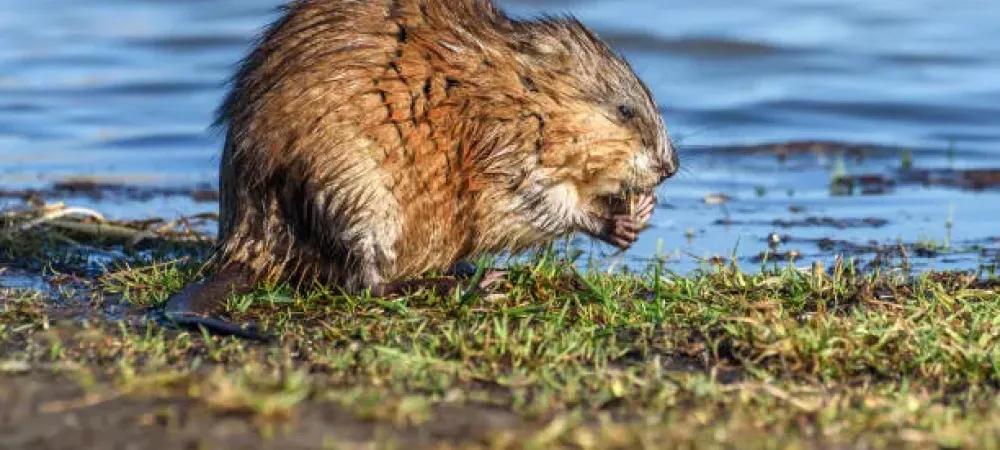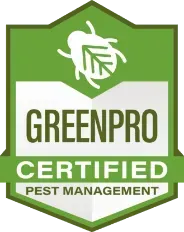What Is A Muskrat and Is It Dangerous?

One of the joys of living in a rural or suburban setting is getting to see wildlife. One of the most common animals found across North America is the muskrat, but most people don’t know what one looks like. In fact, most people have seen a muskrat before, they just didn’t know it. If you live near a body of water then chances are you have seen muskrats. Like most wild animals, you don’t want to get too close to these aquatic creatures because muskrats can carry diseases and be aggressive if provoked.
What Are Muskrats?
Muskrats are medium-sized semi-aquatic rodents that live in native wetlands, rivers, and lakes across North America. From a distance, Muskrats can be mistaken for beavers or groundhogs. One of the most obvious ways you can tell the difference is by looking at the tail. Beavers have large flat tails while muskrats have long, hairless tails like a rat. Their hind feet are partially webbed to aid in swimming.
Different Types of Muskrats
Despite their appearance and diet, muskrats are not related to beavers or even rats. They are the largest species in the subfamily Arvicolinae, which includes voles and lemmings.
Where Do Muskrats Live?
Muskrats live around bodies of water and prefer at least four to six feet of still or slow-moving water. Their range extends from northern Canada to some parts of northern Mexico. They enjoy plants such as cattails, pondweeds, bulrushes, and sedges. Common areas muskrats can be found are:
- Swamps
- Rivers
- Ponds
- Marches
- Drainage Ditches
- Canals
- Reservoirs
When Are Muskrats Active?
Muskrats are crepuscular animals which means they are most active during the twilight periods with peak activity near dawn and dusk.
What Do Muskrats Eat?
Muskrats are omnivores which means their diet consists of a balance of meat and vegetables including:
- Cattails
- Sedges
- Rushes
- Water Lilies
- Other Pond Weeds
- Clams
- Mussels
- Snails
- Crayfish
- Frogs
- Small Fish
Are Muskrats Dangerous?
Muskrats are increasingly common in urban areas as humans expand into their territory. They are timid creatures and will usually run away or hide under the water if humans are near. But if they are cornered or provoked they will defend themselves. Muskrats are also capable of transmitting various diseases to humans, such as rabies.
Do Muskrats Bite?
Muskrats are not aggressive by nature. However, If it feels threatened or its babies are in danger, you can bet that muskrats will defend themselves. Muskrats have large front teeth like beavers and large claws for digging. So if they have to, they will bite.
What Attracts Muskrats To Your Yard?
When muskrats are looking for a new home there are two things they are looking for: water and food. If you have a pond with lots of aquatic plants or even a vegetable garden, this could be the clincher for hungry muskrats. Muskrats don’t just eat water plants but are very fond of vegetables such as:
- Corn
- Soybeans
- Wheat
- Oats
- Grain
- Sugarcane
Why Are Muskrats Bad For Your Home?
In nature, muskrats play an important role in keeping the aquatic plant populations in check and providing meals for a number of carnivores such as coyotes and foxes. When they get into our private ponds and water features, they can cause some problems. Muskrats can damage dams, aquatic plants, and feed on your fish.
As mentioned earlier, muskrats can also carry parasites and bacteria that could be transmitted to other animals that live in or drink the water. Muskrats have also been found to be carriers of tularemia, which can be passed to humans.
How To Keep Muskrats Away
Even if you love animals, sometimes they can be a nuisance when they get into our yards. Muskrats are no exception. Their digging and burrowing can cause a lot of damage to landscapes and yards. Below are some ways to keep muskrats away from your water features.
Use a Liner
One way to deter burrowing muskrats is to place a plastic liner in your pond or along the banks. This will prevent them from digging and cause them to search for another place to live.
Natural Repellents
There are a number of over-the-counter products that you can spray to deter muskrats from setting into your yard. Some effective Muskrat repellents include:
- Cayenne pepper
- Fox urine
- Coyote urine
- Garlic pepper
Install Perimeter Fencing
A long-term solution to keeping muskrats out is installing a perimeter fence. Muskrats cannot climb so the fence does not need to be tall but it does need to be deep to prevent them from digging under it. Fences should be buried at least 6 inches or more.
Attract Natural Predators
You can let nature take its course by attracting natural predators that feed on muskrats. Muskrat predators such as owls, eagles, and hawks can be attracted to the area with the appropriate housing, while snakes and snapping turtles will feed on young muskrats in and around the shore.
Remove Muskrat Food Sources
If you have a small pond, you could remove all the edible plants and animals in and around the water. This will prevent muskrats from settling in.
Hire a Pest Professional
If you do not want to deal with muskrats by yourself or if they are starting to take over, it’s best to call a professional wildlife removal company to get rid of muskrats.


